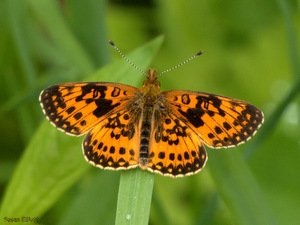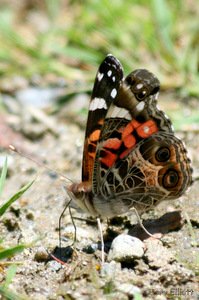 Silver-bordered FritillaryThe benefits of casual browsing struck again when I espied Butterfly People at the Rutland Free Library. A rainbow of multicolored butterflies covered a book set atop the ‘new selections’ case. Like nectar, it drew me in. A quick thumb through revealed many plates of butterflies and moths illustrated with artists’ skillful drawings, saturated with deep oranges, yellows and blues. They evoked a collision of sensuous beauty with scientific detail – wing venation to internal organ systems. Such enticement is the jewel in William Leach’s historic chronicle of nineteenth century America’s infatuation with butterflies.
Silver-bordered FritillaryThe benefits of casual browsing struck again when I espied Butterfly People at the Rutland Free Library. A rainbow of multicolored butterflies covered a book set atop the ‘new selections’ case. Like nectar, it drew me in. A quick thumb through revealed many plates of butterflies and moths illustrated with artists’ skillful drawings, saturated with deep oranges, yellows and blues. They evoked a collision of sensuous beauty with scientific detail – wing venation to internal organ systems. Such enticement is the jewel in William Leach’s historic chronicle of nineteenth century America’s infatuation with butterflies.
The Victorian world is often acclaimed as the ‘heyday’ of natural history. Similar to what I related regarding early gatherers of bird eggs in my review of Oology and Ralph’s Talking Eggs, butterfly collection had become a frenzied mania. To capture hundreds of butterflies during a day’s outing was routine. As with bird eggs, butterflies were a marketable commodity, with advertisers searching for distinct species. Henry Edwards amassed 250,000 specimens.
The adventurous and harrowed lives of many ‘butterfly people’ are outlined by Leach, highlighting the curious ways they became enamored of butterflies. One of the chief collectors, Wm. Henry Edwards was a West Virginian coal mining kingpin. Many had another primary day job: Herman Stecker was a stone mason. Very few arose from a professional science background because they were the first ones writing the biological science of butterflies, dissecting and describing morphology, analyzing and comparing species.
 American LadyTwo of the main contentions were species distinction and taxonomy. Sexual dimorphism of males and females, and sometimes significant changes in the mature winged adult throughout its lifespan, were the source of much confusion and heated debate. Arguments also arose over taxonomic nomenclatures – should it be Linnaean, alluding to antigenic relations, or should just a common vernacular name be attached? Stecker named one moth “Eudaemonia jehovah.” At this even his religious friends thought he had breached conventional standards of decency. Another source of dispute and rancor (Darwin having lately arrived on the scene) was whether each species was a perfected end in itself or represented evolutionary adaptations over eons. In fact, sixty fossil butterflies were discovered during this time.
American LadyTwo of the main contentions were species distinction and taxonomy. Sexual dimorphism of males and females, and sometimes significant changes in the mature winged adult throughout its lifespan, were the source of much confusion and heated debate. Arguments also arose over taxonomic nomenclatures – should it be Linnaean, alluding to antigenic relations, or should just a common vernacular name be attached? Stecker named one moth “Eudaemonia jehovah.” At this even his religious friends thought he had breached conventional standards of decency. Another source of dispute and rancor (Darwin having lately arrived on the scene) was whether each species was a perfected end in itself or represented evolutionary adaptations over eons. In fact, sixty fossil butterflies were discovered during this time.
An interesting parallel between today and these 19th century butterfly people, popped out to me. Today many birders saunter out and post their notable findings on eBird or similar websites and listservs for professionals such as the Vermont Center for Ecostudies, the Cornell Lab of Ornithology, and etc. to encounter, accumulate, consolidate and arrive at hypotheses on species survival or decline, distribution, etc. Similarly the Victorian ‘butterfly people’ often fell into two groups. The collectors did the field work, catching as much as possible and shipping their harvest off to those like Wm. Henry Edwards who spent most of his hours at his desk in his library, examining specimens and writing the first catalog listings of butterflies and moths.
This is a fascinating story, well written, except that I often had trouble keeping straight Wm. Henry Edwards and Henry Edwards, two separate collectors who were close colleagues. It makes one long for earlier decades when there was such a widespread enthusiasm to get outside and experience and learn more about the natural world. Even further, one hopes mankind harbors a deeper reverence for nature beyond the monetary economies of the ‘collecting bug.’
Be sure to check the RCAS Flickr page for more photos of some of the beautiful butterflies that can be seen in Vermont.